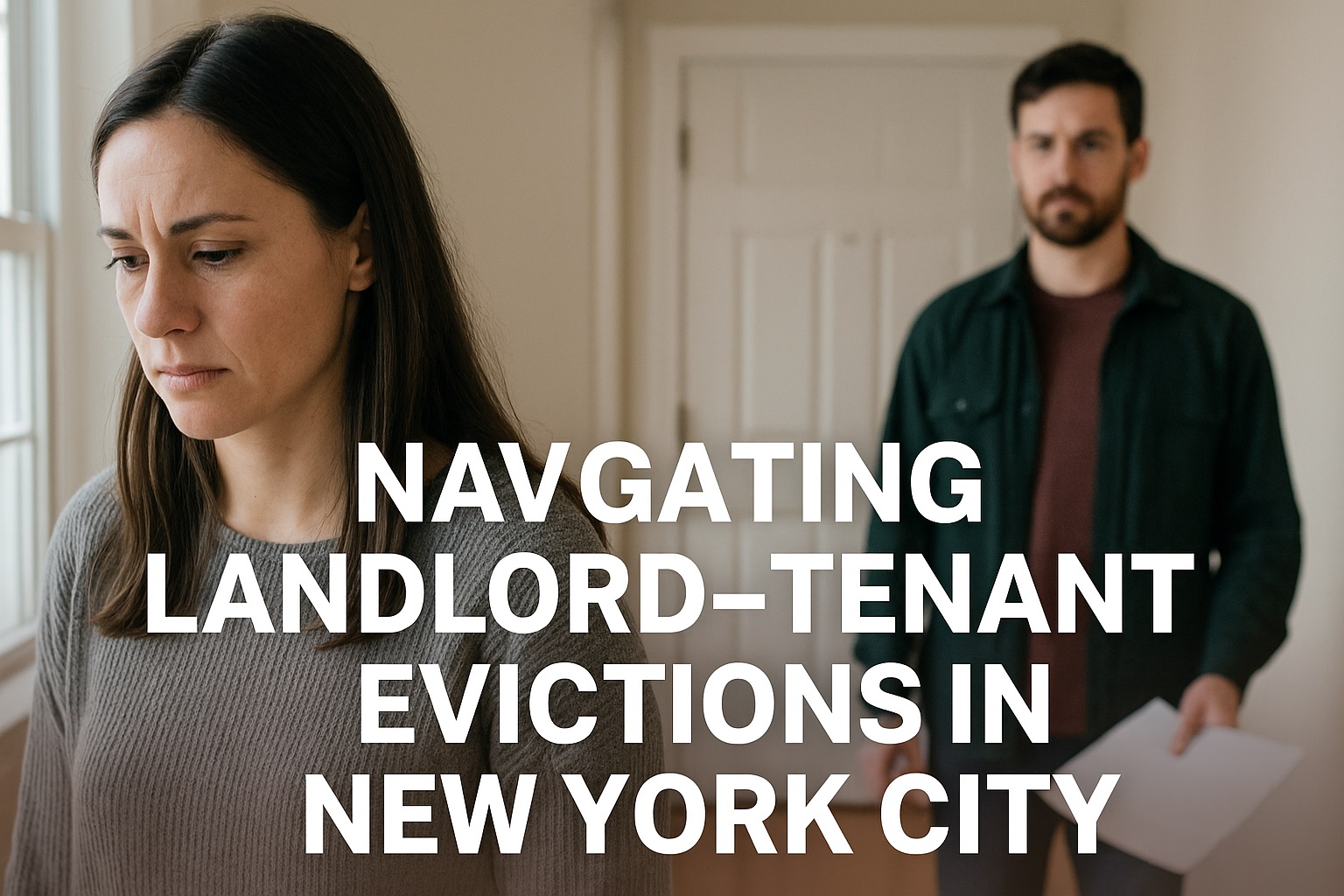Navigating an eviction proceeding in New York City can feel like confronting a legal labyrinth—one filled with strict deadlines, nuanced notices, and complex procedural requirements. As a tenant, your home and your family’s security are on the line; losing at any stage of the process can result in court judgments, forced moves, and even wage garnishments. Yet New York State and City laws provide a range of protections designed to prevent wrongful evictions and ensure that landlords follow every required step. This comprehensive guide walks you through every phase of an eviction action—from receiving the initial notice through trial, judgment, and possible appeals—while equipping you with the most effective defense strategies, procedural tools, and negotiating tactics to preserve your tenancy. By understanding how to document condition issues, challenge defective notices, leverage defenses like warranty of habitability, and navigate New York’s housing courts, you can stand on firm legal ground and protect your right to remain in your home.
1. Understanding the Eviction Process in NYC
Eviction in New York City is governed primarily by New York Real Property Actions and Proceedings Law (RPAPL) and local Housing Court rules. The process typically begins when a landlord issues a written demand—either for payment of rent or for the tenant to correct a lease violation—known as a “notice to cure” or “notice to quit.” After waiting the statutorily required period (three days for nonpayment of rent, generally ten days for lease violations), the landlord may file a petition with Housing Court seeking a holdover proceeding. A holdover proceeding is neither a criminal matter nor a standard civil case; it’s a specialized summary proceeding designed to resolve landlord–tenant disputes quickly. Once the petition is filed and served, you as the tenant have only a few days to file an answer, raise defenses, and request a hearing. Failing to respond can result in a default judgment and an immediate warrant of eviction. If you do answer, you retain the right to present evidence, examine witnesses, and challenge every element of the landlord’s case—title, notice, demand, and grounds for eviction. Throughout, New York’s housing judges wield significant discretion: they may order rent deposits into escrow, grant adjournments for repairs, and even dismiss the petition if the landlord violated procedural rules. Understanding each step—notice, petition, service, answer, hearing, judgment, warrant—empowers you to raise defenses proactively rather than scrambling for last-minute lifelines.
2. Key Notices, Timing, and Service Requirements
One of the most critical aspects of defending an eviction is ensuring that the landlord strictly complied with notice and service requirements. For nonpayment of rent, RPAPL § 711 dictates that a three-day notice must be served, specifying the amount owed, the rent period, and where payment can be made. If the notice is ambiguous—fails to specify the precise rent due or lumps charges improperly—it may be deemed defective, warranting dismissal. For lease violations, RPAPL § 713 requires a minimum ten-day notice, giving the tenant an opportunity to cure the violation before proceedings commence; some violations (criminal activity, illegal subletting) allow no cure period at all. Service must be made personally, by substitute service (leaving with a person of suitable age and discretion and mailing), or by affixture if prior attempts fail—each governed by precise timelines and affidavit requirements. Mistakes in the affidavit of service—incorrect dates, wrong recipient descriptions, failure to file the affidavit in court—can result in vacated petitions. Additionally, rent-stabilized tenants have extra protections: before any holdover proceeding, the landlord must file a “rent history” with New York State Division of Housing and Community Renewal (DHCR) and, in some boroughs, use DHCR forms for the notice. Failure to meet these specialized obligations can be fatal to a landlord’s case. By scrutinizing every date, signature, and procedural step on the notices and affidavits, you can often stop an eviction before it reaches a hearing.
3. Asserting the Warranty of Habitability Defense
Under the landmark implied warranty of habitability doctrine, codified in New York Real Property Law § 235-b, landlords must maintain rental premises in safe, clean, and livable condition. This defense applies when housing code violations—mold, rodents, lead paint, lack of heat or hot water, peeling plaster, broken windows—render the apartment uninhabitable. To leverage this defense, begin by documenting conditions thoroughly: dated photographs, written logs of complaints to building management, and copies of work orders or code violations issued by the Department of Housing Preservation and Development (HPD). When faced with a holdover proceeding, you can file a counterclaim for warranty breach and request a judicial hearing to compel landlord repairs. Many Housing Court judges will require the landlord to deposit withheld rent into an escrow account or issue a warrant of repair, authorizing code inspectors to enter the premises. Successful warranty defenses not only halt evictions but may also entitle you to a rent abatement or money damages. Even if the landlord later repairs, the defense remains valid so long as conditions existed during the period in question. In practice, habitability defenses require cohesive evidence: witness testimony from neighbors or code inspectors, HPD violation records, and airtight timelines showing repeated landlord notice and inaction.
4. Raising Procedural Defects and Technical Defenses
Beyond habitability, eviction petitions are rife with procedural pitfalls landlords often overlook. Common technical defenses include: (1) improper party naming—if the petition lists an incorrect landlord entity or fails to include an assignee; (2) incorrect lease annexation—when the landlord fails to attach the controlling lease or omit addendums; (3) failure to join essential parties such as guarantors who remain liable under the lease; and (4) miscalculated rent figures—landlords must break down charges accurately. You can also challenge court jurisdiction if your building is subject to a Section 8 housing voucher program, or if the premises fall under specific public housing regulations. Filing a “pre-answer motion” to dismiss on these grounds, or simply raising them in your answer, can force the landlord to refile the petition properly—delaying the process by weeks or months. During hearings, you can demand strict proof of every element: presentation of the original lease, proof of ownership through a recorded deed or current tax bill, and precise accounting records. Many landlords rely on boilerplate petitions with generic allegations; by demanding particularized facts and documentation, you shift the burden back onto the landlord and often win adjournments or dismissals.
5. Financial Hardship and Rent Relief Programs
In recent years, New York City has enacted rent relief programs to assist tenants facing eviction due to financial hardship. Administered through the Mayor’s Office of Housing Recovery Operations (HRO), Emergency Rental Assistance Program (ERAP) provides funds to cover past due rent and utility arrears for qualifying households—often allowing tenants to pay a token amount (5%–10% of arrears) to the landlord and HRO covers the rest. To use this defense, you must apply for ERAP before the hearing, present the application receipt to the judge, and, if approved, request a stay of eviction pending payment. Judges frequently grant stays of up to 60 days for ERAP processing. Additionally, tenants can cite documentation of unemployment benefits, medical bills, or other extraordinary expenses to demonstrate hardship under Judicial Standards. Some courts even allow deposit of withheld rent into escrow and ordering landlord acceptance as a condition to vacate. By staying abreast of application deadlines, required documentation, and program guidelines, you not only delay eviction but often secure complete arrears relief, preserving your tenancy permanently.
6. Negotiation, Mediation, and Settlement Strategies
Not every eviction needs to be decided at trial. Housing Court offers free mediation services, where a neutral facilitator works with both parties to reach mutually acceptable terms—often involving payment plans, modest rent increases, or landlord concessions on repairs. Entering mediation requires filing a request before the hearing date and attending at least one session. Successful mediations can result in a stipulation of settlement, which the judge then “so orders,” creating an enforceable court order separate from the original petition. Crafting a realistic proposal—such as paying a small monthly surcharge or committing to timely rent payments in exchange for withdrawn proceedings—can satisfy landlords and avoid formal judgments. Even outside formal mediation, skilled tenant advocates negotiate directly: you might propose a rent escrow covering only current rent, or offer to switch to a market-rate lease after arrears are paid. Document all agreements in writing, have the landlord sign, and file them with the court to ensure binding effect. These settlement pathways often preserve landlord–tenant relationships and spare tenants the trauma, expense, and credit harm of default judgments.
7. Preparing for Trial: Evidence, Witnesses, and Courtroom Tips
If your case proceeds to trial, preparation is paramount. Begin by drafting a clear timeline outlining every notice, rent payment, repair request, and court submission. Assemble documentary evidence: the original lease, repair logs, paid rent receipts, photographs, code violation letters, correspondence with management, ERAP application filings, bank statements, and housing inspection reports. Identify potential witnesses: neighbors who can attest to building conditions, housing inspectors, social service providers, or co-tenants. Practice direct and cross-examination questions to expose inconsistencies in landlord testimony. On trial day, arrive early, dress conservatively, and bring multiple organized copies of exhibits for the judge, opposing counsel, and your own reference. When examining witnesses, speak clearly, maintain respectful tone, and avoid argumentative banter. Use demonstrative aids such as side-by-side photo comparisons or annotated repair logs to illustrate your points succinctly. Judges appreciate concise legal arguments; cite the exact RPAPL sections, housing code provisions, and relevant case law supporting defects or defenses. After presenting your case, close with a summary recapping the landlord’s failures—defective notice, uninhabitable conditions, procedural missteps—and request dismissal or judgment in your favor.
8. Judgment, Warrant of Eviction, and Post-Judgment Relief
If the judge rules against you, they will issue a judgment directing eviction and may set a date for issuance of a warrant of eviction. You have limited options: you can immediately move out voluntarily, request a stay of execution (often requiring bond or deposit of owed rent into court), or file a motion to vacate the judgment based on newly discovered evidence or excusable default. A motion to vacate must be filed within thirty days of judgment and demonstrate a reasonable excuse for any missed deadlines, plus a meritorious defense. Courts may grant stays for up to fourteen days to allow relocation or appeal. You can also appeal the judgment to the Appellate Term of the Supreme Court, Housing Part, though appeals involve higher filing fees and stricter procedural rules. During stays or vacatur motions, maintain rent deposits in escrow to show good faith. In extreme hardship cases, you might seek emergency temporary housing through NYC’s Department of Homeless Services, though eviction judgments can complicate eligibility. Understanding these post-judgment avenues gives you critical breathing room and may prevent immediate homelessness.
9. Seeking Legal Assistance and Tenant Advocacy Resources
New York City offers numerous free or low-cost legal services for tenants facing eviction. Legal aid organizations—such as New York Legal Assistance Group (NYLAG), Legal Services NYC, and the Urban Justice Center—provide representation, advice, and court accompaniment. Tenant unions and neighborhood associations often maintain “tenant hotlines” and community paralegals who can help prepare documents. Many housing courts have self-help centers staffed by attorneys who can review forms, explain basic procedures, and suggest defenses. For rent relief applications like ERAP, HRO runs dedicated call centers and on-site navigators at community boards. When selecting counsel, look for attorneys experienced in Housing Court, familiar with local judges, and adept at both litigation and mediation. Even if you must pay private counsel, initial consultations are frequently free, and many accept payment plans or contingency arrangements for habitability claims seeking money damages.
10. Proactive Measures to Avoid Future Eviction Risks
After resolving an eviction petition—whether through dismissal, settlement, or judgment—you can reduce future risk by taking proactive steps. Maintain meticulous rent payment records: always pay electronically or get written receipts. Document building issues and landlord communications: email copies of every repair request and follow up in writing. Understand your lease terms: be aware of renewal deadlines, rent increase caps (especially in rent-stabilized units), and renewal option exercise requirements. If your building has recurring code violations, consider petitioning for tenants’ association status under NYC’s Tenant Harassment Prevention Task Force to leverage additional enforcement tools. Stay informed about rental assistance programs: the city and state periodically launch new grants or low-interest loan programs for renters. Finally, build good faith with your landlord: respectful communication, reasonable negotiation, and timely cooperation on minor repairs foster goodwill, which can pay dividends if financial challenges arise.
Conclusion
Eviction in New York City is a formidable process, but tenants are far from powerless. By mastering the procedural requirements—notice, service, answer—and deploying substantive defenses like warranty of habitability, financial hardship claims, and procedural defects, you can halt or significantly delay eviction actions. Leveraging mediation, rent relief programs, and strategic settlements often secures your continued tenancy without a trial. Should litigation become unavoidable, thorough preparation, compelling evidence, and skilled courtroom advocacy can result in dismissal or favorable judgments. Even after judgment, post-judgment motions and appeals provide additional safeguards. With the wealth of legal aid resources and statutory protections at your disposal, you can transform an eviction crisis into an opportunity to assert your rights and obtain relief. Equip yourself with knowledge, organize meticulously, and fight with every legal tool available to protect the roof over your head.








